Stories from the rollercoaster of his life flow out of Frank Earl.
By his early twenties he was an internationally renowned wrestler with a villainous reputation performing around the world, England, Canada, Japan, Australia.
Here’s just one story:
The King and I:
In 1969, Thailand was virgin territory for wrestling.The country had a king, Bhumibol Adulyadej Rama, but Thailand was in reality run by the army.
King Rama owns huge indoor tennis courts in Bangkok,and these were to be the venue for our first match. Ranjid Singh,our promoter, had booked two nights for wrestling, and everything was set to go.
By the time of the match, King Rama had realised that I was getting along very well with his supremely glamorous daughter. We ourselves were like rock stars.
The King decided to cancel the second nights wrestling, so that I would be out of the country as quickly as possible.
This was unfortunate, because both nights were sold out. Word went round Bangkok that the second night would not take place, and everyone with a ticket for the second night turned up on the first.
The ancient building had two wooden doors, each one was ten feet wide and twenty feet high and a foot thick, with metal reinforcing strips.
As soon as the place was full of people, ushers closed the doors to keep the rest out. Inside, there was not even standing room, thousands of people were squashed in like sardines. The surge from outside, and pressure from thousands of bodies,brought the huge doors crashing down onto the people standing inside.
Amazingly, no one was hurt.
It was too late to do anything now, and Steve Rickard decided that starting the match would prevent the public from going on a rampage. I had to step on the heads of the people to get to the ring.
I was 24 years old.
Wild Times
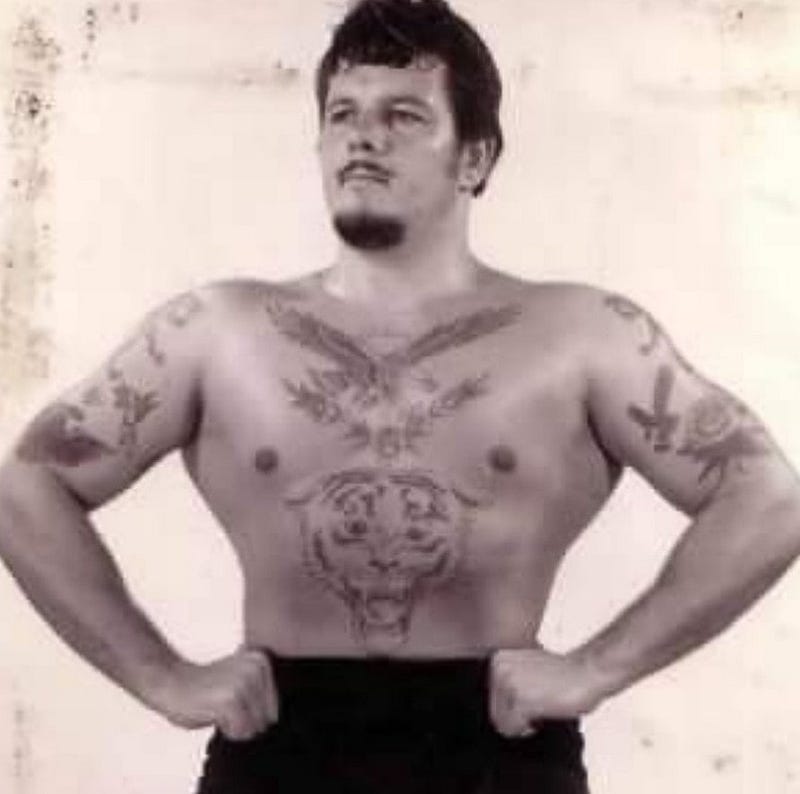
In Singapore in 1969, promoter Steve Rickard had managed to get away from the old system of having rounds, like boxing, and brought in time-limit wrestling matches.
On one show, a one-hour six-man tag team was advertised. The capacity crowd enjoyed the match, until the fall was taken after 40 minutes, and the match ended. They considered that they had been ripped off, and that a one-hour time limit match should actually last an hour.
I remember that someone shouted something in Chinese, and the riot was on.
It was raining bricks and bottles, and a rambutan tree landed in the ring.
A wrestler by the name of King Kong, as well as Rickard and myself, were trapped.
We tried to take refuge under the ring, but it was set on fire.
We were fighting for our lives.
The stadium lights were put out, by whom I don’t know, but he was probably on our side, as it allowed us to find a broom cupboard and barricade ourselves in. We were there for a night and a day before riot police could get us out, but it was business as usual the following Saturday.
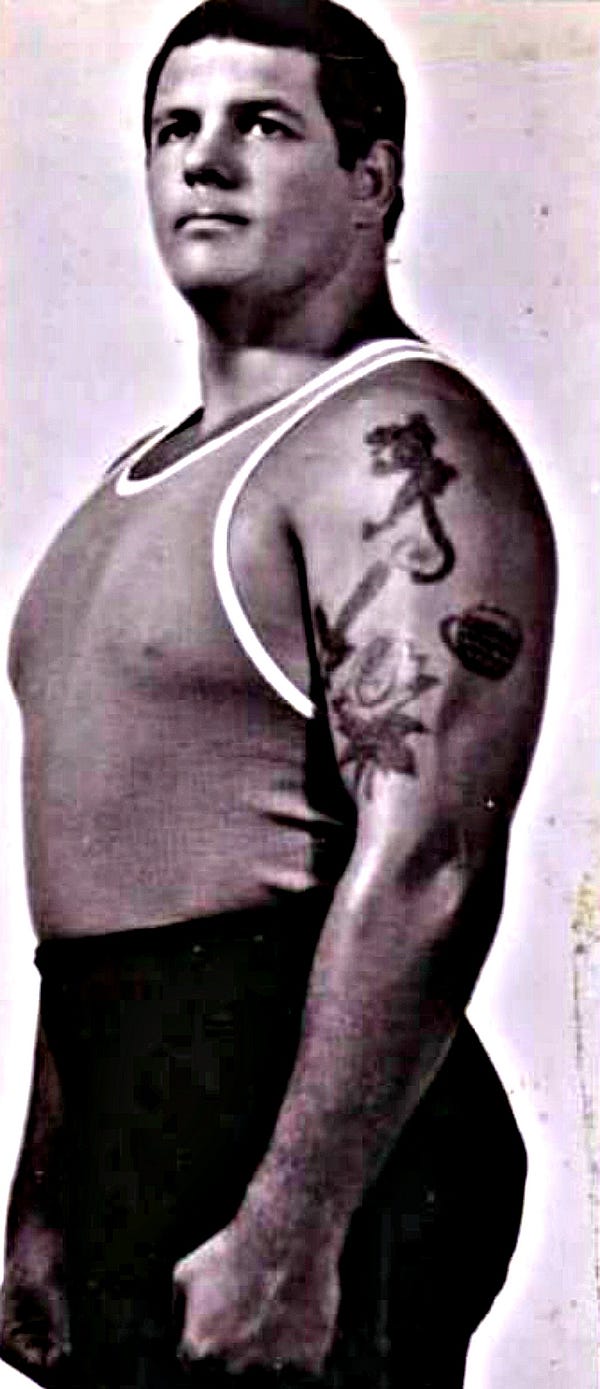
When I started wrestling in 1965, I worked for Hal Morgan, an ex-wrestler who promoted in Sydney. There were hundreds of servicemen clubs, surf clubs, sailing clubs, rugby league clubs, soccer clubs and so forth which had wrestling every week.
The wrestlers were wrestling every night, sometimes twice a night, dashing from one venue to another.
This is how we gained the experience which was to be so valuable in our careers.
In my time, America had its small halls and independent promoters, and American novice wrestlers could always nip over the border to Canada. Gene Kiniski, Stu Hart, Rudy Kay, and Montreal promoters would give them a break. They could then return to America seasoned professionals.
This opportunity is denied to people trying to make the grade in the business today.
Aspiring wrestlers pay teachers to learn the basics, but wrestling in a gym is not like wrestling in front of a crowd of fans.
The psychology and timing which is so important for a good match can only be learned in the ring.
Hal Morgan, the promoter I worked for in Sydney, was very tough and sadistic. He was an excellent submission wrestler, specializing in tearing peoples heads off. Wrestler Lennie Holt found this to his cost, lying still with sandbags either side of his head in hospital after falling foul of Hal.
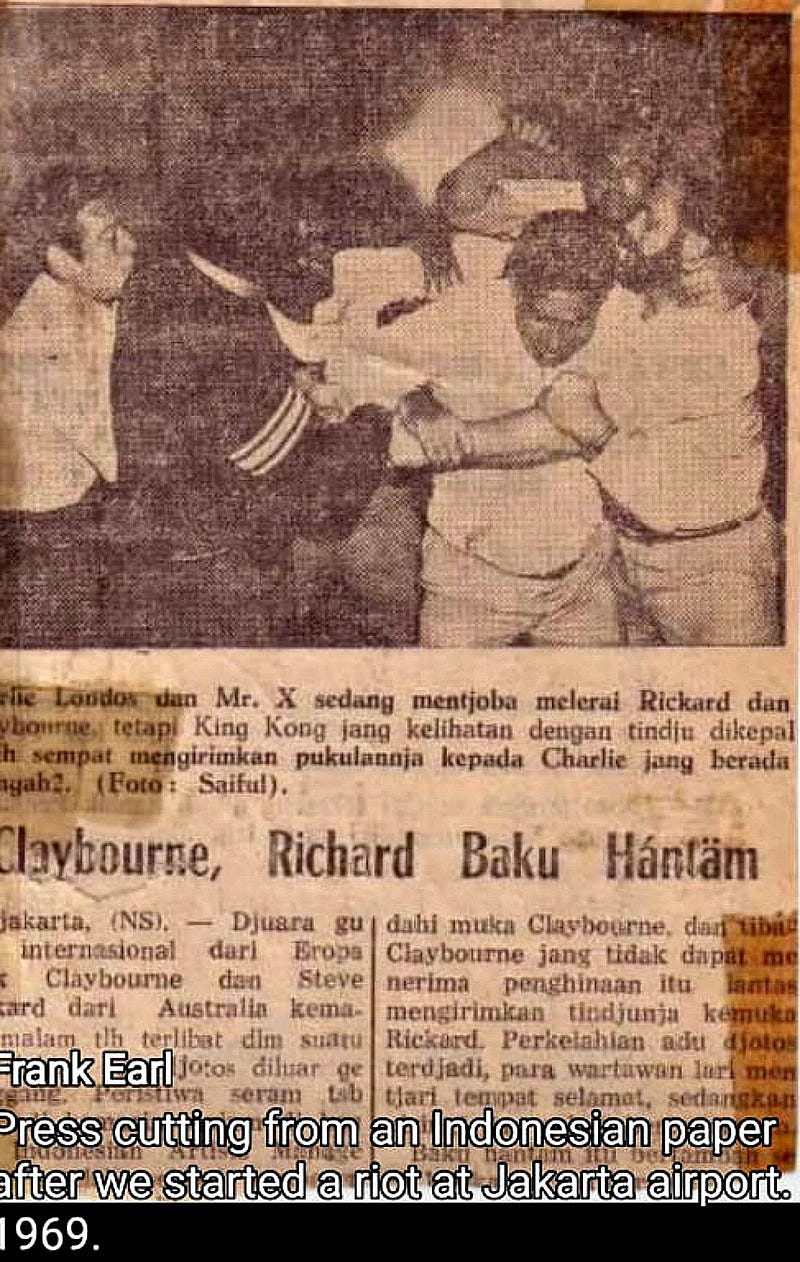
When international wrestlers were based at Singapore in the sixties,we commuted to Hong Kong, Taiwan, Thailand, China, Borneo, Malaysia, and Japan.
A probe was made into having the first ever wrestling match in Indonesia.
The situation was volatile,as Indonesia was run by the army,with a virtual dictator in charge. The match was arranged by Ranjid Singh, the Singapore movie producer who was promoting the wrestling.
His excellent contacts and publicity machine ensured full houses wherever we went.
I travelled to Jakarta,the capital,with Steve Rickard of Australia,and King Kong from Hungary. As we got off the plane and went into the terminal, Steve spotted our opponents, Shintaro Fuji, Charlie Londos from Greece,and Jack Claybourne of France.
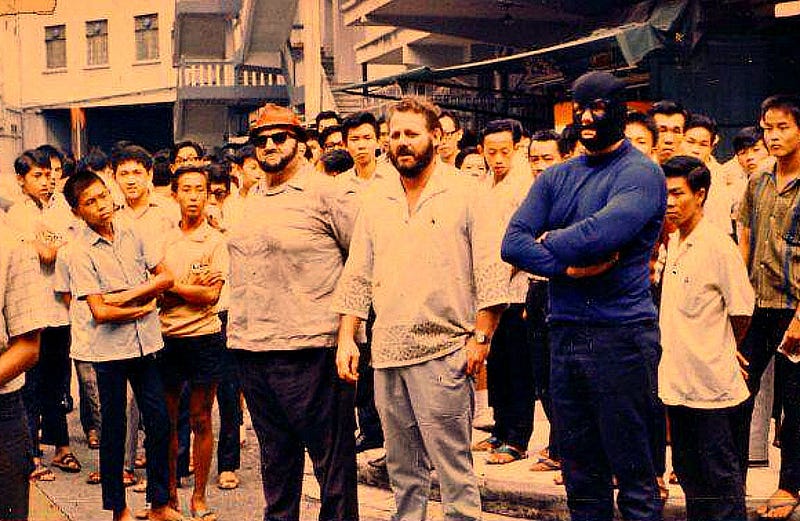
Not one to miss an opportunity, Steve thought this would be a good chance for some publicity if we beat up the other wrestlers in front of the press and photographers.
Steve set about Charlie Londos,I clocked Shintaro Fuji, and King Kong bashed Claybourne.
We did not anticipate the riot which would ensue.
The airport erupted with a mass of brawling bodies,many did not know why they were fighting. Security guards fired warning shots above our heads, but by now it had become difficult for the wrestlers to get out of the way.
The sound of gunfire brought soldiers running,who started shooting at the wrestlers. Steve found an escape route,and we fled through it onto the runway, where a light aircraft was taxiing for takeoff. Steve jumped in and told the pilot to go, King Kong and I followed.
The army was still shooting at us, but the pilot could not speak English,and was trying to get us out of the plane. When bullets ricocheted through the fuselage, he stopped arguing and took off.

In the old days, Chicoutimi in Quebec was known as the wrestlers graveyard. All the fans attacked the wrestlers, and you had to fight your way out.
Today, not many fights involving fans occur at wrestling matches. Perhaps they don’t want to be thrown out after paying $100 a ticket.
Hard Boiled Haggerty, who played the blacksmith in “Paint Your Wagon”, had his arm broken there. Montreal was very rough too. Some of its arenas had a tunnel from the ring to the dressing room for the wrestlers to escape,and a cage to stop fans jumping into the ring.
This did not stop them throwing darts, or squirting bleach from washing up liquid bottles, or taking the odd shot at you.
One wrestler was laying close to the ropes in a new York match, when a fan appeared from nowhere,stuck a sharp knife or scalpel into his hip,and sliced his leg down to the ankle,right down to the bone.
Some Canadian towns used their ice rink for a wrestling venue. The ring sat untethered on the ice,so if someone was thrown at the cornerpost,the ring shot across the ice.
On one such occasion in Lethbridge,I was entering the ring wearing only boots and tights, when a youth threw a boiling cup of coffee over my back.
I turned quickly and caught the hood of his anorak as he ran, swung him round my head a few times,and let him go. He slid across the ice at speed on his back,and crashed into the barrier, much to the amusement of the crowd.
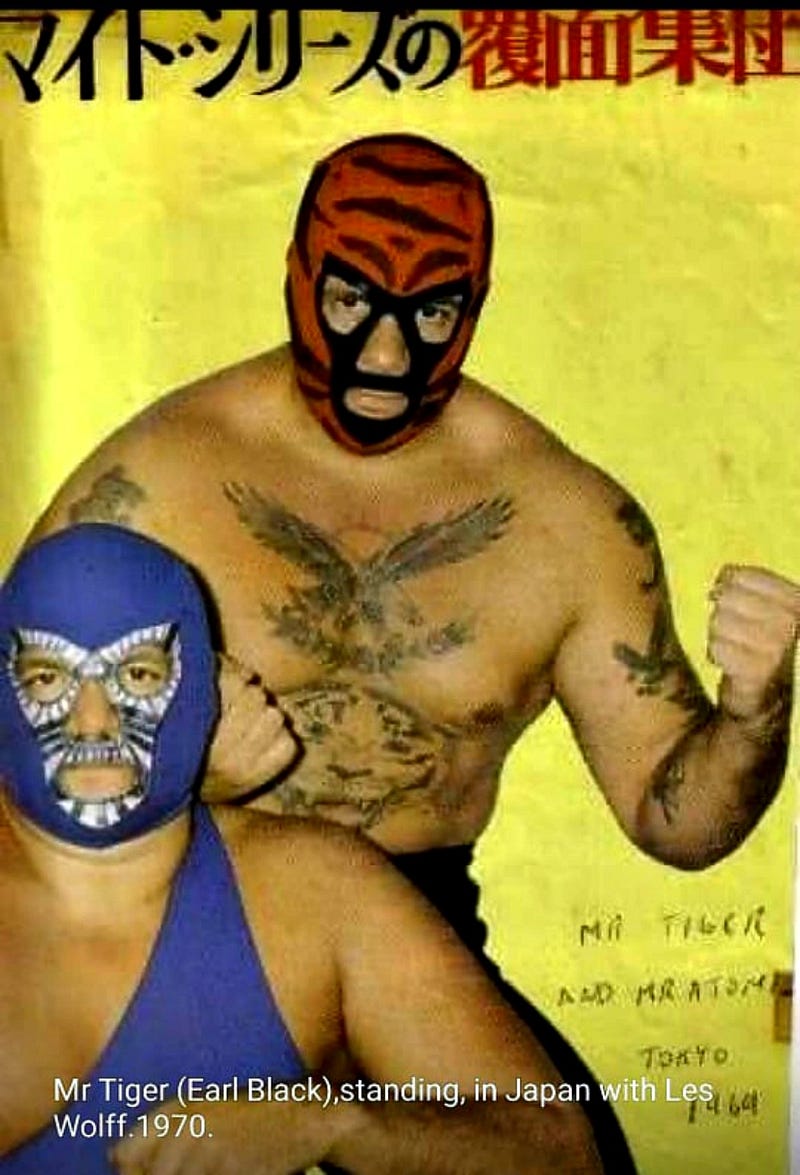
I was wrestling at a lumberjack camp near a town called Kamloops in 1971, in the wilds of Canada,with my partner Angelo Mosca. We beat up two French wrestlers,which did not go down well with the lumberjacks, who were all French.
They surrounded the ring as we tried to leave, but the 6ft 4 300lb Mosca sent them flying all over the place. As a gridiron player for Notre Dame and hamilton Tiger cats, he could run 100 yards in 11 seconds,carrying a 70 pound pack. He was a big, fit man. Footballers know how to use their shoulders to tip someone off balance, and Mosca cleared a path for me.
I was also his partner in Vancouver, where he had crippled Vancouver star Willie Fleming. He had a face which would frighten the Marines, a deep voice, and a filthy laugh.
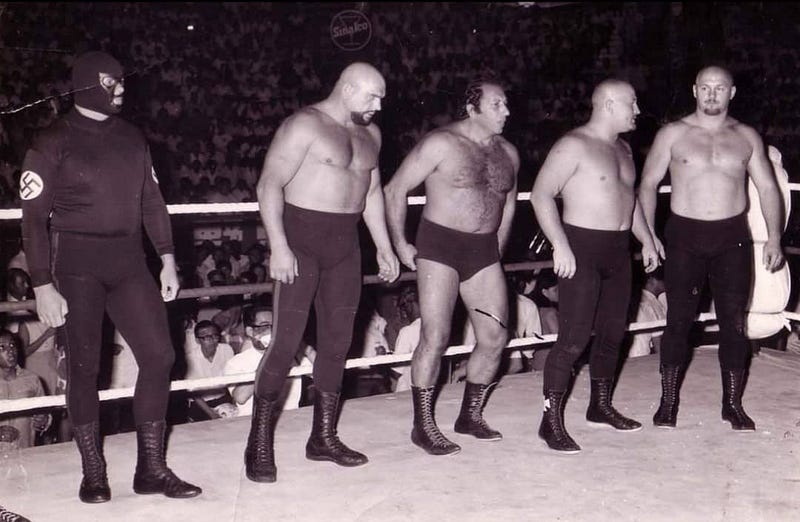
Two hundred miles away from Calgary is Edmonton. Big John Quinn almost lost his life there.
It happened during a six man tag, I was partners with Kurt von Hess and Karl von Schotz, Quinn’s team was himself, Dan Kroffat, and Bill Cody. I started the match wrestling Danny Kroffat. Our team plan was to drag Quinn, the “heavy gun” to our corner where we could all beat him up, leaving the rest of his team at a disadvantage.
I did not notice Von Schotz tying a noose in the tag rope. Quinn tagged in, and I dragged him to the corner, but instead of battering him, Schotz placed the noose around his neck and threw him out over the top rope. Quinns feet were a metre off the ground, the noose knotted tight, cutting off his air and blood to the brain. I was next to him, could see he was gone, so I jumped down onto the floor and grabbed his legs to lift him and take some pressure from the noose.
The mob thought I was pulling on his legs to make it tighter, and attacked me. I managed to get my body underneath Quinn for a moment, but the sheer weight of bodies pushed me away. Quinn’s face by now had gone from white to blue and was now black. His black tongue lolled on his chest, I knew he was dead or near it.
Suddenly, a flash of light just above my head, and Quinn fell to the floor. I did not know what happened at the time, I was just grateful he was not still hanging from the corner post. Danny Kroffat managed to pull the noose off, and Quinn was given mouth to mouth. A couple of hours later, he was all right, but how close was that?
It turned out that the flash of light was a Bowie knife about two feet long. Whether it was aimed at the rope, or aimed at my head, but missed and cut the rope, we never found out, but I felt the wind of it going past. The man with the knife vanished in the melee.
When I left Calgary with Angus to go to Kansas City in 1972, I did not tell anyone where I was going,which hotel,or when we would get there. Despite this,a welcoming party of blondes were waiting for us at the hotel. Angus gave them an earful and they left. The girls who follow wrestlers have a “bush telegraph” to send information around the world. They know who is appearing and who is wrestling under another name in another territory, even Japan.
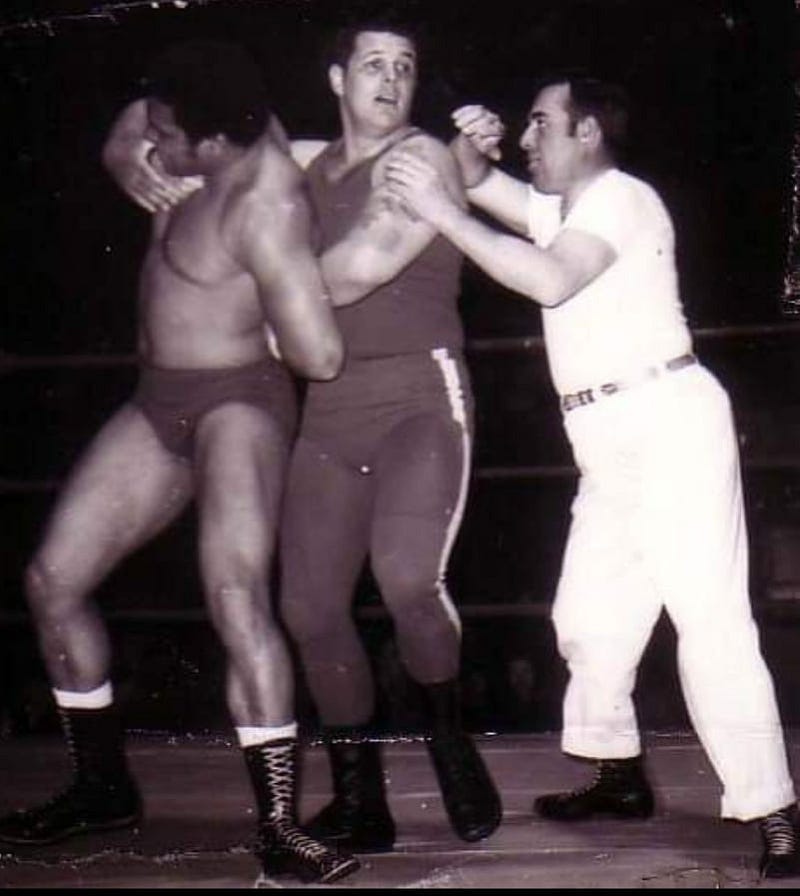
By the time Earl Black was 27 it was all over.
A doctor once explained to him that every fall in a wrestling ring is like “getting rear-ended by a car travelling at 20 mph.”
Frank “Earl” Black, who toured the world as a pro wrestler from 1966 to 1973, begs to differ. “Forget that,” said Black, “it feels like 60 mph!”
Black’s career came to a conclusion for the simple reason that his back simply unable to take any more.
My back was just blathered. I could hardly walk, and things were getting on top of me. The only hospital that would operate on me was in London, so I hoped I could go there, get fixed, and get back in the ring. But it didn’t turn out like that.
After retiring, returned to England. He helped run a plant hire business with his family. Had two children.
His son Wes Brown, who fights as Earl Black Junior, followed in his father’s footsteps, becoming a professional wrestler while working as a lecturer in creative writing.
He writes affectionately about life with his father.The Wrestlers
In the autumn I went along with my dad to Runcorn Wrestling Alliance’s training gym and on the train we talked about…www.litro.co.uk
These days Frank Earl divides his time between Leeds and Saigon. He still goes to the gym four days a week.
After decades of being out of the business, Black retains fond memories of his time as a wrestler.
As he told A Sense of Place Magazine:
I wish that I could do it all again, and I wouldn’t change a thing. Even now, I get emails from all over the world. It is nice to be remembered. People tell me I have had a wonderful life. I tell them that I am still having a wonderful life.
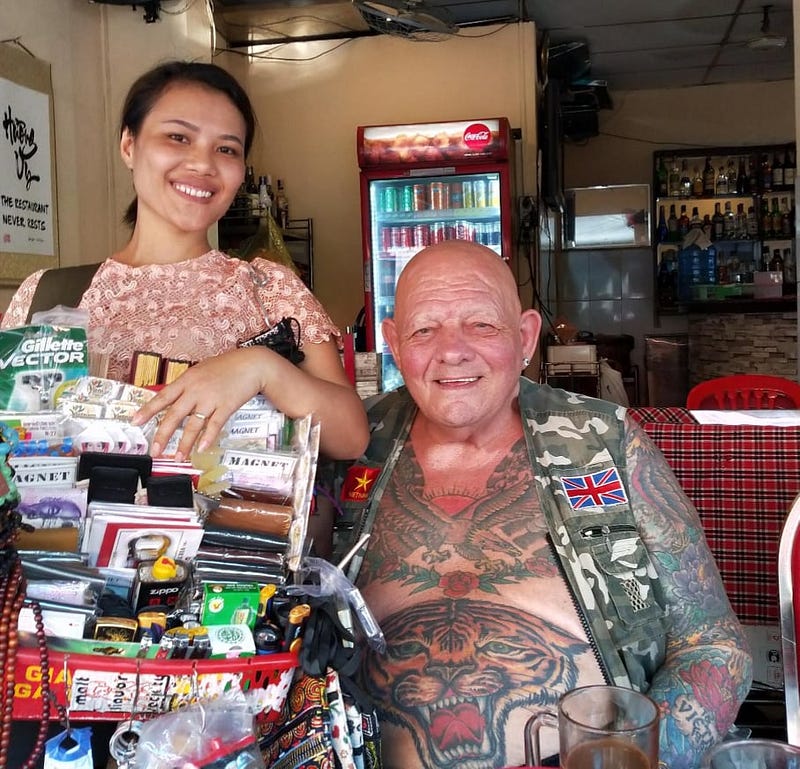
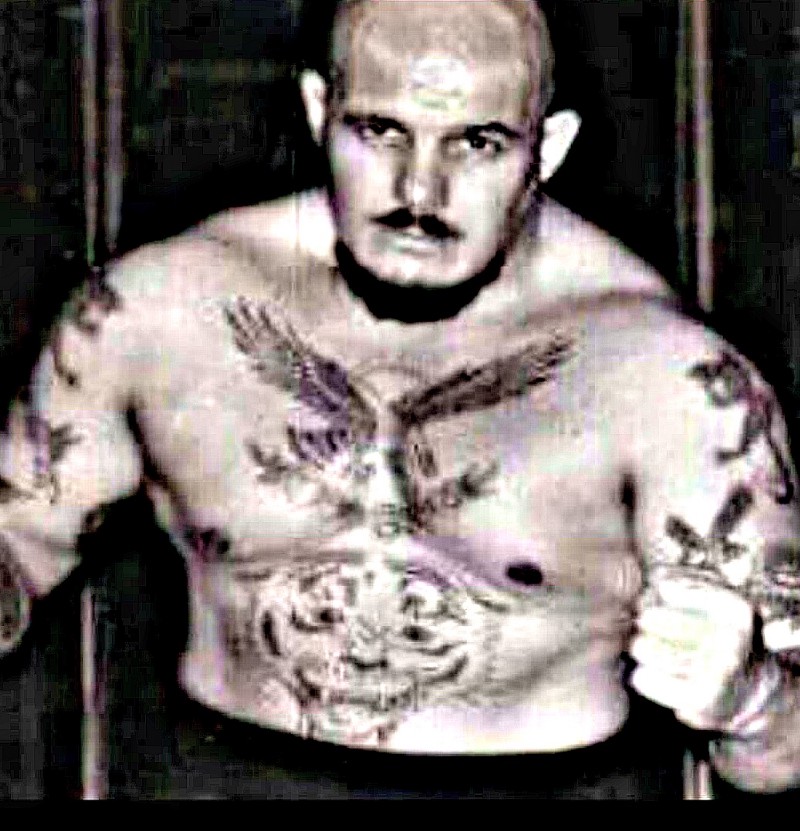
May 15, 2020 at 8:11 pm
Good Work Mr. Frank Earl, I hope to see you soon in Saigon. This was well written, engaging, entertaining, and educational. Dinner and beer on me when we meet up in Vietnam. FB James Joseph,
February 20, 2021 at 9:09 am
Good work Frank..remember training with you and my brother Kevin Lamb..love hearing about your life ..life to the full..
Keith.